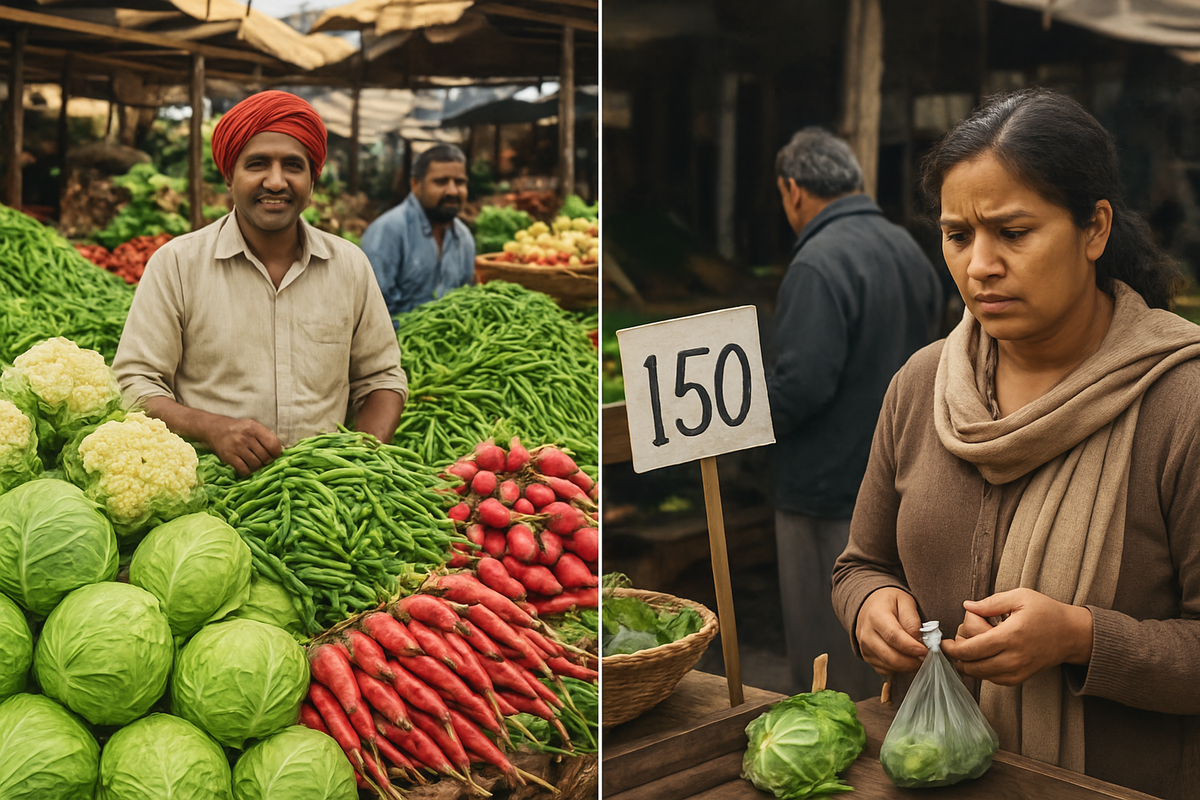
Bogura, Bangladesh – As the crisp air of late autumn ushers in the winter vegetable season, markets in Bogura are presenting a perplexing paradox: despite the fresh arrival of seasonal produce, consumers are grappling with persistently high prices. This situation, unfolding in mid-November 2025, paints a challenging picture for household budgets already stretched thin. While wholesale markets buzz with activity and farmers express contentment with initial prices, the relief is yet to reach the retail level, where a significant gap between farm-gate and consumer costs continues to widen.
The primary culprit behind this elevated pricing appears to be a bottleneck in the supply chain, exacerbated by earlier agricultural setbacks. A confluence of factors, including limited quantities reaching retail outlets, the lingering effects of unseasonal rains on early crops, and the pervasive influence of middlemen, is conspiring to keep essential winter vegetables out of reach for many. This economic strain highlights a systemic issue within the agricultural distribution network, leaving consumers frustrated and questioning the efficacy of market oversight.
The Unfolding Scenario: A Tale of Two Markets
The current situation in Bogura's vegetable markets presents a stark contrast between wholesale and retail dynamics. As of early November 2025, major wholesale hubs like Mahastan Hat, a significant agricultural trade center in North Bengal, have reported a robust influx of early winter vegetables. Farmers, having successfully brought their produce to market, are largely satisfied with the prices they are receiving. For instance, cauliflower has been trading at a wholesale rate of Taka 25-30 per kg, beans at Taka 70-75 per kg, and cabbage at Taka 28-35 per piece. This healthy farm-gate pricing suggests a promising start to the season for cultivators.
However, the narrative shifts dramatically upon entering Bogura's retail markets. Here, the arrival of new winter vegetables has offered little respite, with prices remaining excessively high and subject to daily fluctuations. Consumers are witnessing week-on-week increases of Taka 5 to Taka 20 per kilogram across various items. Brinjal, for example, is being sold for Taka 60-140 per kg, while hyacinth beans can fetch Taka 100-160 per kg. This significant disparity points to inefficiencies and potential profiteering within the supply chain. The timeline of events leading to this moment includes unseasonal and excessive rainfall earlier in the year, which severely damaged many vegetable seedbeds and affected early potato and vegetable cultivation, leading to lower yields and increased pest infestations. This initial disruption to supply, combined with the current retail bottlenecks, has created a challenging environment for consumers. Key stakeholders involved include the farmers, who are getting decent wholesale prices; the middlemen, who are reportedly capturing a large share of the profits; the retailers, who are experiencing a slump in sales due; and ultimately, the consumers, who bear the brunt of the high costs. Initial market reactions are characterized by consumer frustration and a call for greater government attention to market regulation.
Corporate Crossroads: Who Wins and Who Loses?
The current state of Bogura's winter vegetable market, marked by high retail prices despite new harvests, primarily impacts local agricultural ecosystems and consumer spending rather than directly influencing major publicly traded companies. However, the dynamics at play could have ripple effects on various segments of the broader economy.
On the losing side, consumers are undeniably the most affected, facing increased cost of living and reduced purchasing power for essential food items. This can lead to a shift in consumer spending patterns, potentially reducing discretionary spending on other goods and services, which could indirectly affect retail sectors beyond food. Local small-scale retailers in Bogura are also feeling the pinch, reporting a slump in sales as consumers buy smaller quantities or opt for cheaper alternatives. For these businesses, already operating on thin margins, reduced turnover can threaten their viability. Furthermore, if the trend of unseasonal rains and crop damage persists, it could negatively impact agricultural input suppliers, such as companies providing seeds and fertilizers, if farmers reduce their cultivation efforts in subsequent seasons due to increased risk or higher input costs. While specific publicly traded agricultural input companies might not be directly tied to Bogura's local market, a broader trend of agricultural instability in key farming regions could eventually affect their sales and revenue.
Conversely, the primary beneficiaries in this scenario appear to be the middlemen and intermediaries within the supply chain. Research indicates that prices can surge by as much as four times between the farm gate and retail markets, with middlemen allegedly reaping substantial profits, sometimes capturing 50-65% of the price increase. This highlights a lucrative, albeit controversial, opportunity for those controlling the distribution channels. While these are typically not publicly traded entities, their increased profitability comes at the direct expense of both farmers and consumers. In the long run, if large-scale food distributors or supermarket chains (e.g., ACI Limited (DSE: ACI) or Meghna Group of Industries (not publicly traded but a major conglomerate with food interests) were to establish more direct sourcing channels from regions like Bogura, they could potentially benefit from securing produce at lower wholesale prices. However, the current fragmented nature of the market suggests that such large players might not yet be fully leveraging these local supply chains in a way that significantly impacts retail prices for the average Bogura consumer. The high prices also indirectly benefit farmers in the short term, as they are receiving satisfactory wholesale prices for their early winter crops, providing them with a lucrative start to the season.
Broader Implications and Market Undercurrents
The situation in Bogura's winter vegetable markets is more than just a local price fluctuation; it reflects broader industry trends and systemic challenges within the agricultural sector. The most significant underlying trend is the increasing vulnerability of agricultural production to climate change. The unseasonal and excessive rainfall earlier in the year, which damaged seedbeds and early crops, is a stark reminder of how unpredictable weather patterns can disrupt supply chains and inflate food prices. This aligns with global concerns about climate resilience in agriculture and the need for adaptive farming practices.
The pronounced role of middlemen and the significant price discrepancies between wholesale and retail markets highlight persistent inefficiencies and a lack of transparency in the food supply chain. This issue is not unique to Bogura but is a common challenge in developing agricultural economies, where fragmented distribution networks can lead to exploitation and inflate consumer costs. Such inefficiencies can have ripple effects, discouraging farmers from investing in increased production if they feel their efforts are not adequately rewarded at the consumer end, and simultaneously burdening urban populations with higher living costs. Regulatory and policy implications are significant; there is a clear need for stronger market oversight, better enforcement against alleged extortion, and initiatives to streamline the supply chain. Authorities might consider promoting farmer cooperatives, investing in cold storage facilities, and improving transportation infrastructure to reduce reliance on multiple intermediaries. Historically, similar situations of price hikes due to supply chain issues and adverse weather have prompted calls for government intervention, price controls, or direct procurement schemes, though their effectiveness has varied. The current scenario could serve as a catalyst for renewed efforts to modernize agricultural marketing and distribution systems in Bangladesh.
Looking Ahead: Navigating the Market's Future
The coming months for Bogura's winter vegetable market present a mixed bag of possibilities, challenges, and potential strategic shifts. In the short term, traders anticipate that prices will gradually decrease as the winter season progresses and the supply of vegetables further increases, reaching its peak. This natural market correction could offer some relief to beleaguered consumers. However, the underlying vulnerabilities, particularly concerning weather patterns, remain a significant concern. If unseasonal weather continues to affect subsequent plantings, the anticipated price drops might be less pronounced or short-lived, leading to sustained market instability.
From a strategic perspective, the current situation underscores the urgent need for adaptations across the agricultural value chain. Farmers might need to explore more resilient crop varieties and cultivation techniques to mitigate the impact of unpredictable weather. For local governments and agricultural bodies, there's an opportunity to implement policies that enhance market transparency and reduce the influence of exploitative intermediaries. This could involve strengthening market monitoring, establishing direct sales points for farmers, or providing incentives for efficient logistics and cold chain development. Market opportunities may emerge for businesses that can innovate in supply chain management, perhaps through technology-driven platforms that connect farmers directly with retailers or consumers, thereby bypassing multiple layers of middlemen. Challenges will persist for low-income households, who will continue to struggle with food affordability. Potential scenarios range from a gradual return to more stable prices if supply normalizes and oversight improves, to a more volatile future where climate impacts and supply chain inefficiencies continue to drive price spikes, necessitating more robust government intervention and consumer support mechanisms.
A Season of Scarcity Amidst Abundance: The Path Forward
The current high prices of winter vegetables in Bogura, despite their arrival, serve as a potent reminder of the complex interplay between agricultural production, market dynamics, and consumer welfare. The key takeaway from this event is the critical importance of a resilient and transparent supply chain. While farmers are receiving satisfactory prices at the wholesale level, the benefits are not translating to affordable prices for consumers, largely due to inefficiencies and the alleged profiteering by intermediaries. This disparity highlights a fundamental disconnect in the market, where the abundance at the farm gate is effectively nullified by bottlenecks further down the distribution line.
Moving forward, the market will likely be characterized by continued vigilance. Consumers will be closely watching price movements, hoping for the anticipated drop as peak winter supply floods the markets. For policymakers, the event underscores the necessity of robust market regulation and initiatives aimed at streamlining the agricultural supply chain, possibly through investments in infrastructure, support for farmer cooperatives, and stricter enforcement against unfair trade practices. Investors in the broader agricultural sector, even those not directly involved in Bogura's local vegetable trade, should pay close attention to trends in climate resilience, supply chain innovation, and government agricultural policies, as these factors will increasingly shape market stability and profitability. The lasting impact of this period of high prices could be a renewed push for systemic reforms to ensure that the bounty of a good harvest translates into tangible benefits for all stakeholders, from the farmer to the dinner table.
This content is intended for informational purposes only and is not financial advice


















